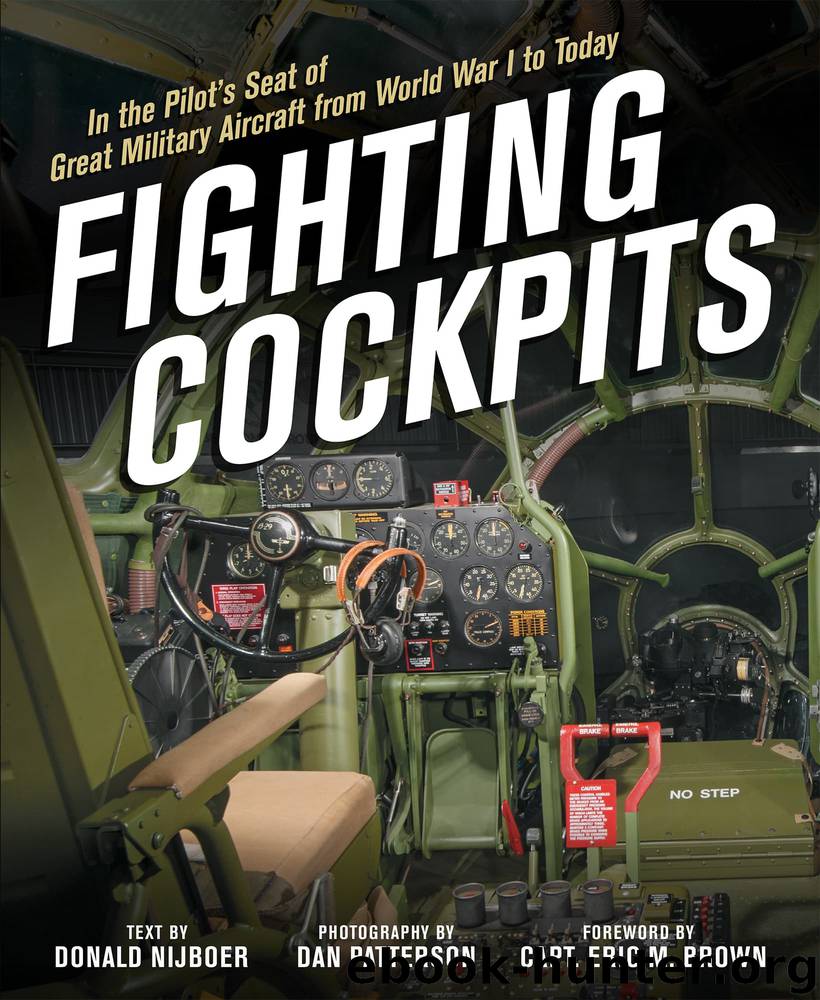Fighting Cockpits by Donald Nijboer

Author:Donald Nijboer
Language: eng
Format: epub
Publisher: MBI
Published: 2016-11-26T05:00:00+00:00
PILOT IMPRESSIONS
James Bradley, Canadian Warplane Heritage Museum
My nickname for the Firefly is “the beast.” It’s a big, heavy aircraft built like a tank. All the engine cowlings are 1/8-inch-thick (3.18-millimeter) steel. Because of the structural support they give, we won’t run the engine up without them.
While it’s bigger than the Spitfire or Mustang, the visibility from the cockpit forward and behind is fairly good. I was surprised, given the large Griffon engine. The pilot sits quite a bit forward compared to normal fighters, and when you look down, the leading edge of the wing is close to the cockpit.
Compared to the Mustang or Corsair, the Firefly cockpit is wider and more comfortable, but with less legroom. I’m 6 feet (183 centimeters) tall and with the rudder pedals all the way forward it’s a very tight fit. The seat doesn’t move straight up and down. If you have a taller body length and want to drop the seat down, it slides forward on an angle. If you have the seat all the way up it gives you better legroom; slide it down and you lose it. The Firefly, being a reconnaissance antisubmarine aircraft, requires cockpit room for your arms in order to use the map board and to navigate.
The noise level in the cockpit is considerably louder than the Corsair or Mustang. In the Corsair all the exhaust ducting comes out the bottom of the engine with very little engine noise. In the Mustang the exhaust has a more popping sound. The “beast” sounds like a shotgun.
Download
This site does not store any files on its server. We only index and link to content provided by other sites. Please contact the content providers to delete copyright contents if any and email us, we'll remove relevant links or contents immediately.
| Automotive | Engineering |
| Transportation |
Small Unmanned Fixed-wing Aircraft Design by Andrew J. Keane Andras Sobester James P. Scanlan & András Sóbester & James P. Scanlan(32693)
Navigation and Map Reading by K Andrew(4973)
Endurance: Shackleton's Incredible Voyage by Alfred Lansing(4635)
And the Band Played On by Randy Shilts(2091)
The Box by Marc Levinson(1905)
Top 10 Prague (EYEWITNESS TOP 10 TRAVEL GUIDES) by DK(1903)
Wild Ride by Adam Lashinsky(1903)
The Race for Hitler's X-Planes: Britain's 1945 Mission to Capture Secret Luftwaffe Technology by John Christopher(1772)
The One Percenter Encyclopedia by Bill Hayes(1764)
Trans-Siberian Railway by Lonely Planet(1670)
Girls Auto Clinic Glove Box Guide by Patrice Banks(1657)
Looking for a Ship by John McPhee(1611)
Batavia's Graveyard by Mike Dash(1588)
TWA 800 by Jack Cashill(1571)
Fighting Hitler's Jets: The Extraordinary Story of the American Airmen Who Beat the Luftwaffe and Defeated Nazi Germany by Robert F. Dorr(1548)
Good with Words by Patrick Barry(1547)
Troubleshooting and Repair of Diesel Engines by Paul Dempsey(1534)
Bligh by Rob Mundle(1524)
Ticket to Ride by Tom Chesshyre(1524)
